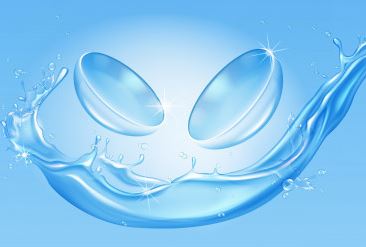
Water content is an important factor to consider when choosing contact lenses. The higher the water content, the more comfortable the lenses will be. In this blog post, we will discuss is higher water content in contact lenses better or not.
Let’s get started.
How much water do contact lenses contain?
Water content is measured as a percentage of the total weight of the lens. The FDA has approved lenses with water contents ranging from 38 to 80 percent. Most contact lenses have a water content between 38 and 55 percent. If you want to get contact lenses without a prescription, visit https://www.contactlenses4us.com/.
- High water content (equivalent to 75%) – Contrary to common opinion, high water content lenses suck out the eye’s tears, making them more prone to dryness. However, the more water in a contact lens, the more oxygen that enters the cornea. Furthermore, high-water-content contact lenses are thought to be simpler to manage while insertion, detaching, cleaning, and sterilizing.
- Medium water content (60%) is acceptable for most lens wearers. They allow oxygen to reach the cornea while preventing the native tear film from collecting water.
- Low water content ( 40%) – Contact lens with a moisture content of around 38% are quite pleasant.
Why does Water Content Matter?
Water is essential for keeping your eyes healthy and comfortable. It helps keep your eyes lubricated and prevents them from becoming dry and irritated. Contact lenses are made of materials that absorb water, so they need to contain enough water to stay hydrated.
If a lens doesn’t have enough water, it will start to dry out and won’t be as comfortable to wear. In extreme cases, it can cause serious damage to the eye.On the other hand, if a lens contains too much water, it can be hard to keep on your eye and may not provide the same level of vision correction. ContactLenses4us.com are the best seller you can get your contacts from.
Permeability of Oxygen and Water in Silicone Hydrogel Lenses and Hydrogel
The permeability of oxygen and water in silicone hydrogel lenses is much higher than that of hydrogel lenses. This is because silicone is more permeable to both oxygen and water molecules than hydrogel.
One of the main benefits of silicone hydrogel lenses is that they allow more oxygen to reach the eye, essential for maintaining healthy corneal function. Additionally, because they are more permeable to water, they tend to be more comfortable for people who have dry eyes.
However, there are also some drawbacks to using silicone hydrogel lenses. One is that they can be more expensive than other contact lenses. Additionally, because they are so permeable to oxygen and water, they can be more prone to drying out and uncomfortable. If you’re thinking about switching to silicone hydrogel lenses, it’s important to talk to your eye care professional about the pros and cons. They can help you decide if these lenses are right for you.
The Bottom Line
So, is the higher water content in contact lenses better? In short, yes. Higher water content lenses are more comfortable, but they also tend to be healthier for your eyes. If you’re looking for the best possible option for contact lenses, you should consider opting for a lens with higher water content.
Interesting Related Article: “Eyeglasses vs. Contact Lenses: Which One is Right for Me?“

